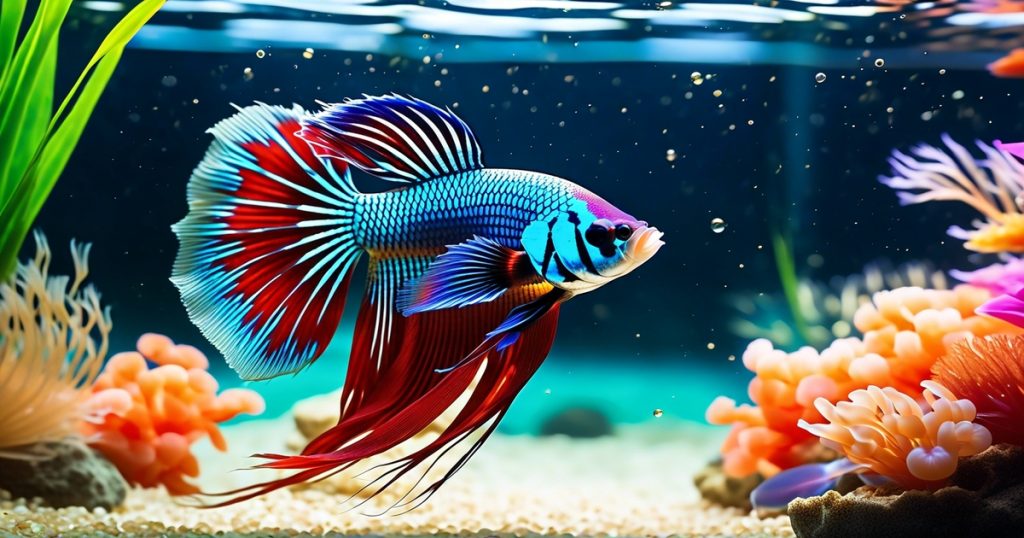Did you know that shrimp and catfish can be excellent tank mates for betta fish? Contrary to popular belief, certain shrimp species can coexist peacefully with bettas, adding vibrancy and diversity to your aquarium. With the right selection and proper care, these aquatic crustaceans not only survive but thrive alongside your betta.
The compatibility factors of fighting fish and corydoras, and ideal tank conditions is crucial for a successful aquatic community. Let’s dive into the fascinating world of betta fish and their compatible shrimp companions.
Table of Contents
ToggleIdentifying Suitable Shrimp Species for Betta Tanks

Popular Shrimp Choices
Cherry shrimp, ghost shrimp, and corydoras are popular choices to coexist with bettas. Cherry shrimp, known for their vibrant red coloration, can thrive in the same water parameters as bettas. Similarly, ghost shrimp and corydoras are peaceful and unlikely to bother bettas.
Both Amano shrimp and bamboo shrimp are also compatible with bettas. Amano shrimp, recognized for their algae-eating abilities, can help maintain tank cleanliness while being non-threatening to bettas. Bamboo shrimp are filter feeders that peacefully cohabit with bettas and other fish.
It’s essential to avoid larger or aggressive fish species that may pose a threat to bettas. Some larger shrimps might become territorial or even attempt to prey on the slower-moving betta fish.
Factors to Consider
When selecting suitable shrimp species, consider the size, temperament, and behavior of your specific type of betta fish. It’s crucial to ensure that the chosen fish won’t cause stress or harm to the peaceful nature of your pet beta.
Before introducing any new fish inhabitants into your tank, it’s recommended to research and understand each species’ compatibility thoroughly. This will help prevent any potential conflicts between the shrimp and your beloved betta fish.
Betta’s Tolerance Towards Shrimp
Varying Degrees
Bettas have varying degrees of tolerance towards tank mates, including shrimp and fish. Some fish bettas may show aggression towards shrimp, while others coexist peacefully. This variation in behavior makes it essential to carefully observe the individual betta’s temperament before introducing any new tank mate.
Understanding individual betta behavior is crucial when introducing shrimp to the tank. If a betta has a history of aggressive behavior towards other fish or small creatures, it may not be suitable to introduce shrimp into the same tank. On the other hand, if a betta fish displays calm and non-aggressive behavior, there might be a higher chance of successful cohabitation with shrimp.
Observing Behavior
When considering adding shrimp and fish to a betta tank, it’s important to start by observing how the betta interacts with its current environment. If the betta shows signs of aggression or stress when introduced to new objects or changes in its surroundings, it might not be compatible with shrimp. However, if the betta fish appears curious but not overly aggressive towards new additions in its habitat, there could be potential for peaceful coexistence with certain types of shrimp.
It is also advisable to introduce hiding spots and plants within the aquarium that can provide shelter for both the betta and any potential shrimp inhabitants. These hiding spots can help reduce stress and minimize direct confrontations between the two species.
Ideal Tank Conditions for Shrimp and Betta Coexistence
Maintaining Water Conditions
To ensure a harmonious environment for shrimp and bettas, it’s crucial to maintain stable water conditions. This includes monitoring and regulating water temperature and pH levels. For instance, both species thrive in temperatures between 75-82 degrees Fahrenheit. Keeping the water quality pristine is essential to reduce stress on both shrimp and bettas.
Proper filtration plays a vital role in maintaining optimal water quality within the tank. By regularly changing the water and ensuring effective filtration, you can create an environment conducive to the well-being of both shrimp and bettas.
Providing Suitable Environment
Ample vegetation serves as hiding spots for shrimp while also creating a visually appealing habitat for bettas. Adding live plants such as Java moss or Anubias not only enhances the aesthetic appeal of the tank but also provides natural hiding places for shrimp, reducing their exposure to potential aggression from bettas.
Creating a diverse environment with plenty of nooks, crannies, and plants helps minimize stress on both species by providing them with areas where they can retreat when needed.
Creating Hiding Spaces for Shrimp in Betta Tanks
Utilize Live Plants
To provide hiding spots for shrimp in a betta tank, consider incorporating live plants like java moss and hornwort. These plants not only offer cover but also create a natural environment that promotes the well-being of the shrimp. For instance, java moss can be attached to driftwood or rocks to form dense, intricate hiding places for the shrimp.
In addition to live plants, you can also introduce aquarium substrates such as fine gravel or sand. This substrate allows the shrimp to burrow and find secure locations within the tank. By combining different types of plants with suitable aquarium substrates, you can ensure there are various options available for the shrimp to seek shelter.
Create Sheltered Areas
Apart from utilizing live plants and aquarium substrate, it’s essential to incorporate other items that serve as cover for the shrimp. Driftwood is an excellent choice as it provides both aesthetic appeal and functional use by offering hiding spaces. Caves or PVC pipes strategically placed in the tank create sheltered areas where shrimp can retreat when needed.
Feeding and Care for Tank Mates in Betta Aquariums
Balanced Diet
Offering a balanced diet is crucial for both bettas and shrimp. High-quality pellets, flakes, and occasional live or frozen foods should be included. This ensures that all tank mates receive the necessary nutrients to thrive.
It’s important to monitor feeding sessions closely to prevent overfeeding or competition for food among tank mates. Bettas can sometimes be aggressive during feeding time, which may lead to uneaten food if not managed properly.
Health Observation
Regularly observing the health and behavior of both species is essential in addressing any care concerns promptly. This includes keeping an eye on the shrimp’s activity levels, ensuring they have access to hiding spaces within the tank, and monitoring their interactions with the betta fish.
Observing how the betta interacts with its tank mates will help you identify any signs of aggression or stress. By doing so, you can intervene if needed to ensure a harmonious community tank environment.
Non-Fish Tank Mates for Bettas
Snails
Betta fish can coexist with shrimp, such as ghost shrimp and cherry shrimp. Snails, like nerite snails and mystery snails, are also suitable tank mates for bettas. These creatures not only add diversity to the aquarium but also help in keeping the tank clean by consuming algae.
In addition to their cleaning benefits, snails are peaceful and unlikely to provoke aggression in bettas due to their non-threatening nature. They’re a great option for hobbyists looking to introduce non-fish tank mates into their betta aquariums without disrupting the harmony of the environment.
African Dwarf Frogs
Another non-fish option that can live harmoniously with betta fish is the African dwarf frog. These small creatures add an interesting dynamic to the aquatic environment and are generally compatible with bettas when kept in a well-maintained aquarium.
African dwarf frogs require similar water parameters as bettas, making them suitable companions for these beautiful fish. However, it’s essential to provide hiding spots and ensure that both species have enough space within the tank.
Risks and Considerations When Introducing Shrimp to Bettas
Potential Aggression
Introducing shrimp to a tank with betta fish can pose risks due to the potential aggression of bettas towards the shrimp. Bettas are territorial by nature, and they may see smaller tank mates like shrimp as intruders in their space. This could lead to aggressive behavior, putting the shrimp at risk of injury or even death.
It’s important to understand that there is a chance of conflict between bettas and shrimp, so careful consideration should be given before introducing them into the same tank.
Gradual Acclimatization
To minimize stress during the introduction process, gradual acclimatization of both species is crucial. This involves slowly introducing the shrimp into the tank environment where the betta already resides. By allowing them time to get used to each other’s presence without direct interaction, it reduces the chances of immediate aggression from either party.
Monitoring Interactions Once introduced, close monitoring of interactions between bettas and shrimp is vital for ensuring the well-being of all tank inhabitants. If any signs of aggression or stress are observed, swift action should be taken to separate them if necessary.
Conclusion
You’ve now got the lowdown on which shrimp can live with betta fish. From identifying suitable shrimp species to understanding betta’s tolerance towards them, and creating ideal tank conditions, you’re all set to create a harmonious underwater community. Remember, providing hiding spaces for the shrimp, ensuring proper feeding and care, and considering non-fish tank mates are crucial for a successful setup. But don’t forget the risks involved when introducing shrimp to bettas – it’s better to be safe than sorry.
Now that you’re armed with this knowledge, go ahead and set up a thriving betta tank with compatible shrimp buddies. Happy fish-keeping!
